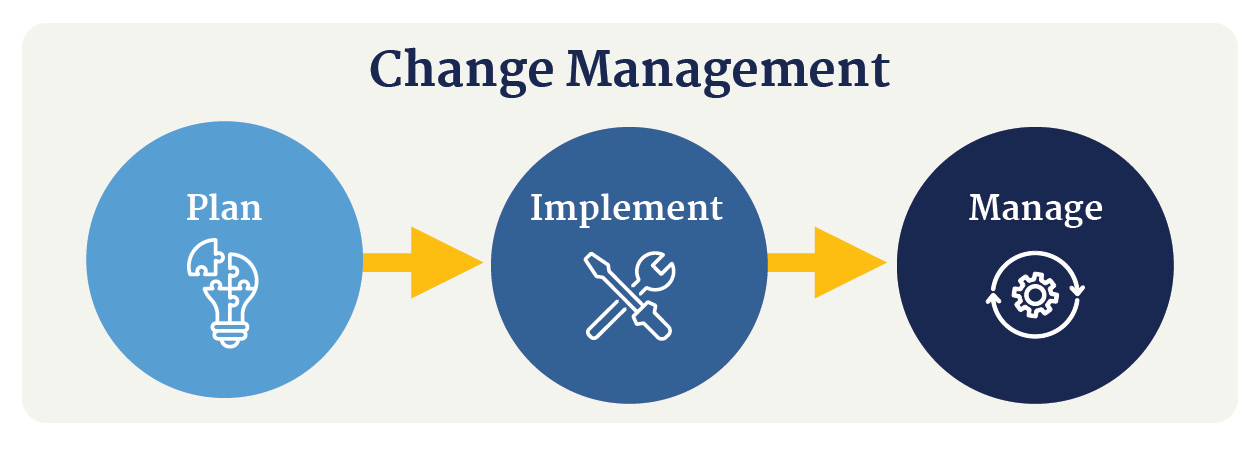Key Takeaways
- Selecting, integrating, and optimizing the right technology successfully is crucial for improving employee satisfaction and customer experience.
- Optimizing technology is an ongoing process that requires regular monitoring and adjustments.
- The right partner will help your organization identify priority needs and provide recommendations to support your goals.
The key to maximizing efficiency is investing in the right technology, integrating it into your processes, and continually optimizing. For growth-focused organizations, this is paramount to maintaining the two most important factors of operating in the current business environment: employee satisfaction and customer experience.
Looking at your daily operations can reveal opportunities to optimize your technology.
Ask yourself questions such as: How are you operating? Where can you make improvements? Would implementing a better business system or process help enable those improvements?
Consider beginning an optimization initiative if:
- Your employees manually handle many aspects of your business. These inefficient and tedious tasks leave little time for employees to do more meaningful, value-added work.
- Key information about your operations and clients is not located in a single area, making information difficult to find and analyze. This leads to delayed, inaccurate, and unreliable information that hinders decision making.
- You rely on physical storage or have fragmented data across departments instead of utilizing a collaborative cloud-based model. This not only poses a significant security risk but also causes internal inefficiencies.
- There is no easy, reliable, secure way for your employees to access essential company data from outside the office, hindering your ability to provide them with hybrid and remote working options.
- Managing and tracking client interactions is challenging and time-consuming, preventing you from making data-driven decisions to enhance the customer experience.
- You lack visibility into your current sales pipeline, future forecasted state, and the ROI of your marketing efforts, leaving you unsure of where to prioritize your time and resources.
Optimizing Your Existing CRM
Before investing in new technology, it's crucial to assess your current systems for optimization opportunities. This approach allows you to maximize existing resources, potentially saving significant time and money.
Here are strategies to optimize your current technology setup:
Conduct a Technology Audit
Start by conducting a thorough audit of your existing MarTech. This involves inventorying all your software, hardware, and systems and assessing their current use within your organization. Identify any redundancies, underutilized tools, or systems that no longer meet your needs.
Streamline Processes
Look for ways to streamline your processes by leveraging the capabilities of your current technology. Often, software and systems have features that are underused or not used at all. Training sessions for staff can uncover these hidden functionalities that can make processes more efficient.
Improve Integration
Assess how well your current systems communicate with each other. Lack of integration can lead to inefficiencies and data silos. Many software solutions offer APIs or have partner ecosystems that allow for integration with other tools. Improving integration can enhance data flow and accessibility, reducing manual data entry and errors.
Upgrade Existing Solutions
Instead of purchasing new solutions, consider upgrading your existing technology. Many vendors offer updates or add-ons that can significantly enhance functionality. An upgrade might also be more cost-effective and less disruptive than implementing a new system.
Implement Automation
Identify repetitive, manual tasks that could be automated. Automation can dramatically increase efficiency and free up employees to focus on more strategic tasks. Your current technology may already have automation capabilities or could be configured to automate tasks through scripting or third-party tools.
Reconfigure and Develop
As your organization changes, so too should your systems. Sometimes taking a step back to reconfigure or add further functionality to fill gaps is needed to make the technology work for your current and future operations. Often, the technology you have in place may be capable, but it just needs to be retooled and optimized to better align to your current processes and organizational direction.
Encourage User Feedback
Gather feedback from your technology's users. They can provide insights into challenges they face, features they wish existed, or functionalities they find redundant. This feedback is invaluable for optimizing technology use.
Prioritize Training and Support
Ensure your team has the training and support they need to use technology effectively. Even the best tools can become underutilized if users don't know how to leverage them fully. Consider ongoing training sessions, creating internal resources, or even having a dedicated support person or team.
Monitor and Adjust
Continuously monitor the performance and usage of your technology and be ready to adjust as needed. This proactive approach ensures that your technology remains aligned with your business goals and operational needs. By optimizing your current technology, you can enhance efficiency, improve employee and customer satisfaction, and ensure your organization is well-positioned for future growth. This strategy also allows for a more informed decision-making process when the time comes to consider new technology investments.
Investing in New Technology
The right CRM tool can help you streamline your business processes, provide a better experience for your customers and employees, and accelerate your growth. CRM solutions come in all forms and functionalities, and no one tool will be the right solution for every organization. When evaluating a CRM, it’s important to understand how customizable and scalable the solution is.
CRM Considerations
When evaluating a CRM, look for a platform that is:
- Cloud-based: You don’t have to purchase, store, and maintain any physical hardware.
- Scalable: As your needs change, the solution can change with you.
- User friendly: You can create applications using point-and-click options instead of investing significant resources into custom coding.
- Regularly updated: You will automatically receive new features and improvements regularly.
- Functional: You can tailor your solution with a mix of different functionalities to support all areas of your organization. The solution can easily integrate with other systems.
The right consulting partner will help your organization outline your priority needs and provide recommendations to shape your technology strategy.
Working with a partner who understands your organization and seeing a demo that highlights exactly how upgrading would benefit your unique business model is important to maximizing ROI.
Preparing for Implementation and Optimization
If you’re ready to make the switch to a new CRM or optimize your current solution to empower future growth, it’s important to plan ahead. Following the right steps prior to undertaking a technology initiative will help the transition go as smoothly as possible. While you can’t prepare for everything, here are a few key areas to keep in mind before you begin your initiative:
Change Management

- Have clear goals in mind for how you want the software to improve your business model. Do you want to increase sales by a certain percentage? Are you hoping for a measurable improvement in your customer support results? This will help guide the scope and ensure the implementation addresses your critical areas.
- Make sure you understand all of the changes that will take place after you implement your solution. Ask questions of your implementation partner and consider workflow changes. Don’t purchase a new CRM license just to copy your current process flow in the new system. Communicate the way you do business so your implementation partner can translate that effectively to the new technology.
- Engage your sales, marketing, and customer support staff. Changes to your CRM will likely mean significant changes in the way they do their jobs. It’s important to keep them involved in the entire process so nothing is overlooked and adoption remains high.
- Invest in training. Prepare for the impending learning curve that will occur when you switch over from your previous business processes and systems. End-user training will cut down the time it takes for your team to ramp up the new tool and process.
Preparing Your Environment
- Take time for your data. Organize and create back-ups. And if you can, take the time to clean up data mistakes (duplicate customer entries, missing/inaccurate information, obsolete accounts).
- Move your data slowly. It can be helpful to create a small test batch (client database entries, for example) to import first. Once you have verified that everything is set up the way you want, you can move the rest of your data.
- Monitor the transition closely. Talk to your employees and customers to figure out where configurations need to be modified and if any additional training is needed.
Ensuring a Successful Initiative
With the right technology in place and integrated processes to improve data visibility and flow, you can improve your organization’s overall efficiency and performance.
Our team of business advisors and consultants can help you build the right solution for your organization, whether that means adding functionality to an existing tool or helping you migrate to a new solution.
Generative AI in Marketing and Sales


